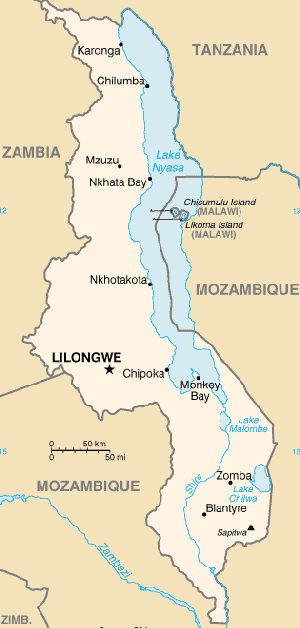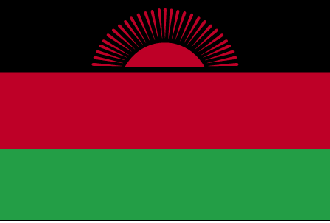
|

Malawi
Background:
Established in 1891, the British protectorate of Nyasaland became the
independent nation of Malawi in 1964. After three decades of one-party rule,
the country held multiparty elections in 1994 under a provisional constitution,
which took full effect the following year. National multiparty elections were
held again in 1999.
Location:
Location: Southern Africa, east of Zambia.
Area: Total: 118,480 sq km, water: 24,400 sq km, land: 94,080 sq km,
Area - comparative: Slightly smaller than Pennsylvania.
Land boundaries: Total: 2,881 km, border countries: Mozambique 1,569 km,
Tanzania 475 km, Zambia 837 km.
Coastline: 0 km (landlocked)
Climate and Terrain:
Climate: Sub-tropical; rainy season (November to May); dry season (May to
November).
Terrain: Narrow elongated plateau with rolling plains, rounded hills, some
mountains.
Natural resources: Limestone, arable land, hydropower, unexploited deposits of
uranium, coal, and bauxite.
People:
Population: 11,651,239.
Ethnic groups: Chewa, Nyanja, Tumbuka, Yao, Lomwe, Sena, Tonga, Ngoni, Ngonde,
Asian, European.
Religions: Protestant 55%, Roman Catholic 20%, Muslim 20%, indigenous beliefs
3%, other 2%
Languages: English (official), Chichewa (official), other languages important
regionally.
Government:
Government type: Multiparty democracy.
Capital: Lilongwe.
Government - note: The executive exerts considerable influence over the
legislature.
Economy overview:
Landlocked Malawi ranks among the world's least developed countries. The
economy is predominately agricultural, with about 90% of the population living
in rural areas. Agriculture accounted for nearly 40% of GDP and 88% of export
revenues in 2001. The economy depends on substantial inflows of economic
assistance from the IMF, the World Bank, and individual donor nations. In late
2000, Malawi was approved for relief under the Heavily Indebted Poor Countries
(HIPC) program. The performance of the tobacco sector is key to short-term
growth as tobacco accounts for over 50% of exports.
Statistics:
Telephones - main lines in use: 45,000.
Telephones - mobile cellular: 49,000.
Radio broadcast stations: AM 9, FM 5 (plus 15 repeater stations), shortwave 2.
Radios: 2.6 million.
Television broadcast stations: 1.
Internet users: 35,000.
Railways: Total: 797 km.
Highways: Total: 28,400 km, paved: 5,254 km, unpaved: 23,146 km.
Airports - with paved runways: 6, with unpaved runways: 37.
Return to Visiting Locations
|

